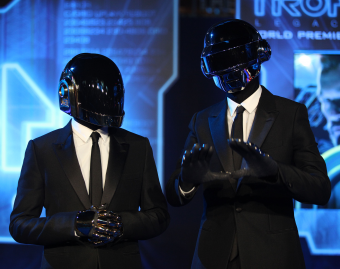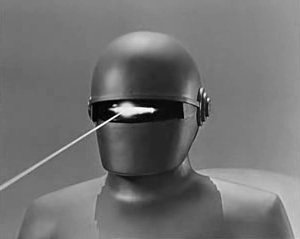Why Do Daft Punk Dress Like Robots?
 Guy-Manuel de Homem-Christo and Thomas Bangalter, more succinctly known as Daft Punk, are arguably two of the most famous and easily recognisable musicians on Earth, having won countless major awards including six Grammys and even managed a “Best Original Score” award for the absolutely amazing Tron: Legacy soundtrack. Despite their extreme success, exceptionally few of their millions of fans actually know what the duo look like. You see, the pair have spent the last decade or so carefully constructing their robotic public alter egos, which begs the question, why?
Guy-Manuel de Homem-Christo and Thomas Bangalter, more succinctly known as Daft Punk, are arguably two of the most famous and easily recognisable musicians on Earth, having won countless major awards including six Grammys and even managed a “Best Original Score” award for the absolutely amazing Tron: Legacy soundtrack. Despite their extreme success, exceptionally few of their millions of fans actually know what the duo look like. You see, the pair have spent the last decade or so carefully constructing their robotic public alter egos, which begs the question, why?
Though today the pair almost never grant interviews and go to rather absurd levels to hide their faces both on stage and in interviews, when they made their first foray into the world of music, they had no such reservations.
Prior to Daft Punk both Guy-Man and Thomas made up two thirds of a rock trio called, Darlin’ which had lacklustre “success” from 1992 to 1993. The band, in which Guy-Man played guitar and Thomas played bass, released a grand total of four songs over their brief, six month long career, two of which appeared on a vinyl compilation album titled, Shimmies in Super 8. The album, of which only about 800 copies were made, is notable for a review it inspired by Dave Jennings of Melody Maker magazine who referred to the band’s sound as “daft punky thrash” (not “a load of daft punk” as many sources suggest). This review was read by the duo who subsequently went on to make it the name of their new band as they reportedly thought it was funny.
As mentioned, while performing as Darlin’, neither Guy-Man nor Thomas made any attempt to obscure their faces. Although it should be noted that they only had two real gigs. They likewise did not try to hide their visages when they initially formed Daft Punk in 1993 following the break-up of Darlin’. This all changed in 1996 (a year before the release of their debut album Homework) when the band began adamantly refusing to be photographed or filmed without obscuring their appearance in some way.
Initially the duo used whatever they had on hand at that moment to hide their faces during interviews, such as shaving cream, swimming goggles and on at least one occasion, a pair of black cloth bags. They also would typically wear Halloween masks for shows. In 1999, while the pair were in the middle of recording Discovery, they began to discuss the idea of constructing alternative identities that “matched the direction of their music” and settled on the idea of quite literally becoming humanoid robots.
To accomplish this goal, Daft Punk approached two artist friends, Alexandre Courtes and Martin Fougerol, who created the initial concept art for what would become Daft Punk’s new robo alter egos. They then took this art to renowned special effects guru Tony Gardner of Alterian Inc, who began the long process of turning it into an actual costume.
 According to Gardner, the design of Thomas’ silver helmet was chiefly inspired by the look of Gort from the 1951 film, The Day The Earth Stood Still whereas Guy-Man’s helmet was initially supposed to be entirely gold, not dissimilar from, to quote Gardner, “a spaceman’s helmet” before the decision was made to include the now iconic LED display.
According to Gardner, the design of Thomas’ silver helmet was chiefly inspired by the look of Gort from the 1951 film, The Day The Earth Stood Still whereas Guy-Man’s helmet was initially supposed to be entirely gold, not dissimilar from, to quote Gardner, “a spaceman’s helmet” before the decision was made to include the now iconic LED display.
The inclusion of so many LED lights in the helmet caused a number of issues during the early phases of construction, forcing Alterian to bring in the guy who designed the Jumbotron. To supply power to the helmets, both of which featured a number of features, such as displaying text and a variety of patterns (controlled by a console located on each of their arms), Guy-Man and Thomas had to wear bulky backpacks containing a power supply and circuitry, from which countless wires could clearly be seen entering the back of the helmet; this added to the effect, giving the appearance of a slick of robotic hair.
Speaking of which, up until literally the last minute, both helmets originally had wigs, which fit with the early concept art provided by Alex and Martin. However, just before arriving at the photoshoot to unveil their new robotic personas in 2001, the duo decided to remove the wigs, feeling that it made them look “sleeker”. Another issue with the earliest models of the helmets was how hot it got inside them, but this was later solved by adding various ventilators.
Upon unveiling their new look, Daft Punk were surprisingly coy about exactly why they’d made the decision to suddenly don robot helmets and gloves. When directly asked, Thomas jokingly responded: “We did not choose to become robots. There was an accident in our studio. We were working on our sampler, and at exactly 9:09 am on September 9, 1999, it exploded. When we regained consciousness, we discovered that we had become robots.”
When asked if the duo were going to wear the costumes on stage, Guy-Man doubled down, stating: “We are robots now.”
Prompting Thomas to add, presumably with a smirk under that helmet: “We don’t wear helmets; everything’s real.”
Over the years as the band has softened somewhat on their stance on interviews, other pieces of information about why they chose to don the suits has come to light. For example, in a 2013 interview with Rolling Stone, the duo clarified that the robot masks were not originally for marketing purposes or to sell records, but to explore the “line between fiction and reality” and create “fictional personas that exist in real life.” Further noting that they thought of the helmets as “sci-fi glam”, in that they represent an obviously exaggerated persona that is distinctly not them.
That said, in the same interview, the duo noted that the robot personas had become an unmistakable part of their draw, quipping: “We’re not performers, we’re not models – it would not be enjoyable for humanity to see our features, but the robots are exciting to people.”
Finally getting to the heart of the original motivation for the masks, they stated,
We’re trying to separate the private side and the public side. It’s just that we’re a little bit embarrassed by the whole thing. We don’t want to play this star… thing. We don’t want to get recognised in the streets…
On that note, a huge benefit of the robot persona is that, despite their superstardom, it’s easy for the pair to go about their daily lives without Daft Punk fans constantly hounding them for autographs or otherwise, as Thomas noted, “reminding me of what I do… It’s nice to be able to forget.”
And for the curious, yes, despite the pair’s sincerest efforts to remain masked, there are plenty of photos out there of Daft Punk without their helmets, though none of which we personally have the rights to publish here. So we’ll just leave you with these links. (Proceed at your own risk; they really do look a lot cooler in robotic form ;-)): Thomas with his wife, actress Élodie Bouchez | Guy-Manuel
If you liked this article, you might also enjoy our new popular podcast, The BrainFood Show (iTunes, Spotify, Google Play Music, Feed), as well as:
- Who Was The Real Man In The Iron Mask?
- Dedication to the Mask- The Story of El Santo
- Where Does the Word Robot Come From?
- The Men Inside of R2-D2 and C-3PO
- Why Superheroes Wear Their Underwear on the Outside
| Share the Knowledge! |
|





Oooor…they could just be ripping off Kraftwerk, or The Droids (or any other 70’s post-“Star Wars” electronic music band).